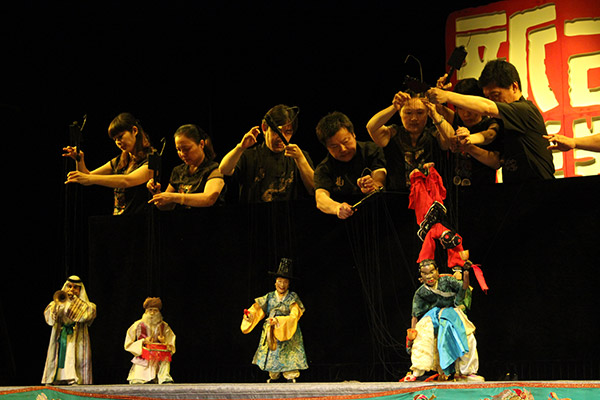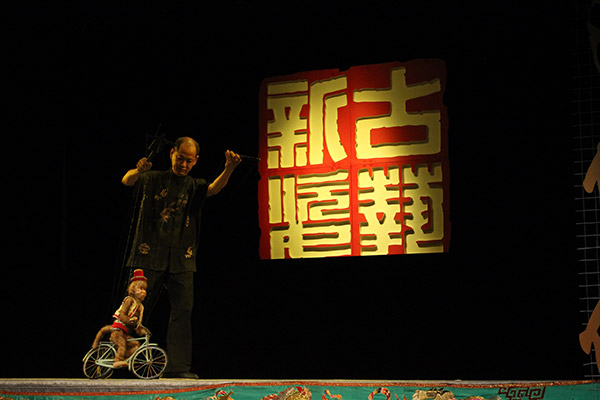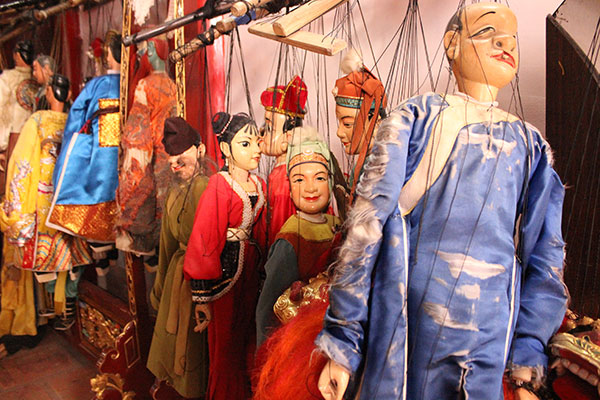
Members of the Quanzhou Marionette Troupe give a performance. The city of Quanzhou in Fujian province is home to traditional Chinese marionette.[Photo by Wang Kaihao/ China Daily]
The 200-year-old yard tucked away in an old neighborhood of Quanzhou, Fujian province, is more like a temple than a theater.
A statue of the “God of Marionettes” is worshipped in the middle of the hall. After burning incense to pay homage to the deity, performers from the Quanzhou Marionette Troupe begin to practice the complex manipulation of the puppets with their fingers.
Xia Rongfeng has been in the troupe for 32 years. He has only accepted two apprentices.
“Not everyone is talented enough to handle 30 strings at the same time,” the stage veteran explains. “I can teach many students, but I am picky when choosing apprentices.”
It can take 10 years of training to become a mature marionette practitioner: from the making of puppets to performance and singing.

Members of the Quanzhou Marionette Troupe give a performance. The city of Quanzhou in Fujian province is home to traditional Chinese marionette.[Photo by Wang Kaihao/ China Daily]
“One of the most important disciplines is that the puppeteers have to participate in every process of the show,” Xia says, clutching his monkey puppet, which has accompanied him for years, and just impressed another audience by riding a bicycle and performing acrobatics.
“Only in that way will they learn to love the puppets like their own children.”
When Xia first joined the troupe they only had 10 puppeteers, who were struggling to revive the thousand-year-old tradition in the aftermath of the “cultural revolution” (1966-76). Luckily for locals, marionettes have always been part of their daily life: In Quanzhou, marionettes are ubiquitous at weddings, funerals and other major celebrations and worshipping ceremonies.
For locals, puppets are the “media between humans and heaven.”
“The development of the marionette basically has two directions: One is closely connected to religious rituals, and the other was born in the theater,” says Wang Jingxian, head of the troupe, a scriptwriter who resigned from his government job in 1992 to promote marionettes. “In Quanzhou, we have both.”

Members of the Quanzhou Marionette Troupe give a performance. The city of Quanzhou in Fujian province is home to traditional Chinese marionette.[Photo by Wang Kaihao/ China Daily]
Marionettes first appeared in the north of China more than 2,000 years ago, but they traveled to Quanzhou via northern immigrants as late as in the Tang Dynasty (AD 618-907). Today, the city has become the home of traditional Chinese marionette.
“What the inheritors of traditional arts fear most is war,” Wang explains. “Continuous wars in northern China during ancient times stopped any chance marionettes had to evolve and develop.
“Though there is some scattered distribution of marionettes in other places in China, Quanzhou is the only place where the tradition has been preserved uninterrupted. Much of the repertoire performed today is from the Southern Song Dynasty (1127-1279).”
Quanzhou Marionette was inscribed in the national intangible cultural heritage list in 2006. It has been shown in more than 60 countries, and its international reach peaked at the opening ceremony of the 2008 Beijing Olympic Games.
Today, the troupe has nearly 70 performers. A new theater, covering more than 10,000 square meters on the outskirts of the city, is set to open soon. It was built thanks to 60 million yuan ($9.7 million) in government aid.
It took Wang 16 years and the writing of endless reports and applications to secure the money.
“This period of time saw intangible cultural heritage enter the public consciousness after years of neglect,” he says. “However, after decades of having little confidence in our own traditional culture, it will take much more to improve awareness.”
He is pleased to have recently opened marionette classes in local kindergartens and elementary schools. He says he does not expect the children to pursue a career in puppetry, but “hopes it becomes a sweet memory of their childhood”.
“It’s our fault if children in Quan-zhou don’t understand marionette,” Wang says, getting emotional. “However, it’s their choice whether they develop an interest in it as adults.”
Tan Xuegang, deputy director of Fujian provincial office protecting intangible cultural heritage, says a project launched in 2006 encourages sustainable development of marionettes.
Tan explains that the project offers economic support for intangible cultural heritage inheritors. A national-level inheritor will get 10,000-yuan subsidy a year to train a new generation of performers. Marionette making and performance departments in Shanghai Theater Academy and several local colleges in Quanzhou have been established to nurture potential practitioners.
The troupe headed by Wang considers it more important to ensure quality work, rather than simply training more performers.
“Intangible cultural heritage has become a hot topic today. Some people are eager to get registered, thinking it will bring them money and fame, but they neglect authenticity.”
Quanzhou Marionette continues to be accompanied by ballads sung in the dialect of southern Fujian. A live band accompanies them using gongs and drums. Wang worries that marionette performers in the rest of the country are no longer able to sing folk songs and instead rely on recorded soundtracks. They also have poor puppet-making skills.
“Still, many label themselves as intangible cultural heritage inheritors. That fad is not right.”
In 2010, the project in Quanzhou was named by UNESCO as an example of how to safeguard intangible cultural heritage. Earlier this year, the UNESCO-led International Training Center for Intangible Cultural Heritage in the Asia-Pacific Region, which is based in Beijing, organized Quanzhou Marionette to tour Cambodia and Indonesia to train people in the two countries on how to preserve their heritage. Quanzhou Marionette will possibly expand to more Southeast Asian countries in the future, according to Tan.
“The folk beliefs and arts in Fujian and Southeast Asia have many similarities and have interacted throughout history,” says Guo Zhan, chairman of World Heritage Institute under China Cultural Relic Academy, referring to Quanzhou’s status as one of world’s leading sea harbors in Southern Song and Yuan (1271-1368) Dynasties.
As China plans to cooperate with neighboring countries in co-bidding for sites along the Maritime Silk Road to be listed by UNESCO World Cultural Heritage locations in the coming years, an integrated regional system of intangible cultural heritage will play an important role, he says.
